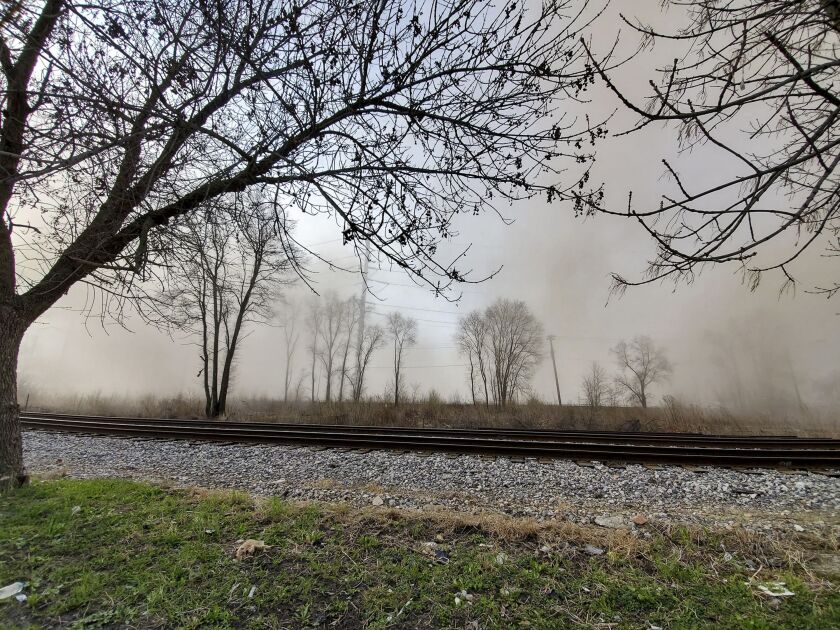Community leaders from Pilsen and North Lawndale on Thursday blamed Mayor Lori Lightfoot and a “corrupt” permitting system that “perpetuates environmental racism” for the disastrous demolition of a 95-year-old smoke stack at the site of the shuttered Crawford coal-fired power plant.
Led by the Little Village Environmental Justice Organization, the groups demanded that City Hall force Hilco Redevelopment Partners to vacate Little Village and rescind the $19.7 million city subsidy of a massive warehouse on the site.
Lightfoot has blamed Hilco for the demolition, which created a giant plume of dust that rained down on the community, making it difficult to breathe during a coronavirus pandemic that does the same. The dust left homes, vehicles, streets and sidewalks filthy and potentially exacerbated a public health crisis.
Kim Wasserman, executive director of the Little Village Environmental Justice Organization, doesn’t buy the mayor’s finger-pointing. She demanded a top-to-bottom overhaul of a permitting system she said allows Hilco and others to “harm black and brown communities.”
“This disaster is a result of a corrupt system that perpetuates environmental racism. This is not about a botched plan or a permit problem. The Crawford implosion exposes that Chicago’s urban development system serves corporate interests at the expense of Chicago’s black and brown communities,” Wasserman said.
“This is about a system where corporations, city departments like the Chicago Department of Public Health and elected officials like Alderman Mike Rodriguez never stop to think that, in the middle of an unprecedented respiratory disease pandemic, it was not right to schedule a dangerous implosion in a community with the second-worst air quality in the state of Illinois.”
Rodriguez said he’s a lifelong Little Village resident and looks forward to working with community to “hold Hilco accountable.” The alderman said he was “opposed to the subsidy during his campaign and is opposed to it now.”
Lightfoot did not respond directly to the community leaders’ demands.
Instead, her statement reiterated the mayor’s claim that the “significant dust emission” was “unacceptable” and that she “responded swiftly” by distributing masks, conducting environmental testing, cleaning the streets and issuing an order immediately stopping all work at the Crawford Power Generating Station.
“I also issued an immediate halt to all non-emergency demolitions city-wide for a week. Further, yesterday I sent a letter to Hilco demanding they provide the City with a comprehensive report detailing the circumstances leading up to, during and after the implosion of the stack, with particular emphasis on the steps they took to contain dust to their site and why those efforts failed,” the mayor was quoted as saying
“In addition to these efforts, I have ordered a thorough review of this incident and will work to ensure incidents like these, never happen again.”
Hilco Redevelopment Partners has apologized to Little Village residents for the “anxiety and fear” caused by the demolition that already has triggered two lawsuits. The company has fired its primary demolition contractor and outlined a plan to mitigate the damage.
Wasserman was not impressed.
“This isn’t a ‘bad apple’ problem. Community harm is stemming from one broken, corrupt racist system. This system cannot be redeemed,” she said.
Wasserman argued implosions are “banned in the city code for demolitions unless Buildings Commissioner Judy Frydland expressly overrides” that ban. She demanded to know why “this exception was made.”
Buildings Department spokesperson Mimi Simon countered: “The city never issued a moratorium on explosives. The use of explosives in construction is reviewed on a case-by-case basis.”
Simon said lab results from dust samples taken from the Little Village site “will inform next steps.” As it waits for those results, City Hall is “working with subject matter experts in all departments to determine if processes need to be tightened or changed regarding demolitions” to ensure nothing like this ever happens again, she wrote.
To show the Little Village demolition was not an isolated incident, Thursday’s news conference included a tearful appeal from Olga Bautista of the Southeast Environmental Task Force. She represents a Far Southeast Side community that has been Chicago’s primary dumping ground for decades.
Wasserman demanded a “first right of refusal” for communities impacted by environmental racism and a “community environmental justice advisory council that works in conjunction with the City Council” to retain the power to veto permits based on public health impact.
“Reforms must empower communities in environmental injustice areas to screen industrial companies, change their plans and reject new or expanded developments that would harm the community,” she said.
“Permitting decisions by any Chicago department and zoning, planning or tax incentive approvals by City Council must factor in a company’s track record and that of their main sub-contractors. Labor violations, environmental violations all should be part of whether new permits move forward.”






